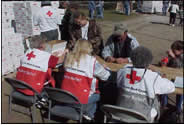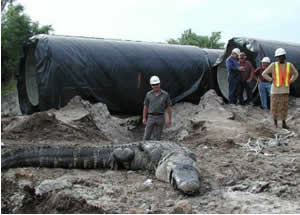
Vol. 3, No. 5, May 2007 |
 Printer-Friendly PDF Version Printer-Friendly PDF Version |
Contents |
Governor Declares State of Emergency
|
| ||||
[top]
Through the Grapevine Shawn Crocker |
Drought and Fire
The Editor
Chris?emails read: "Today's Florida Keetch-Byram Drought Index (KBDI) from the State of Florida Division of Forestry can be found at the following URL: http://redcross.tallytown.com/graphics/kbdi-01.png.?The map at that address is astonishingly red, suggesting that the Sunshine State is bone dry. As of this date, however, nothing is purple ?yet.
As I write this, I am past tired of smelling smoke from the fire in SW Georgia (and as of this moment in my home county of Alachua), but now there is an even more menacing presence, and closer to home: neighborhood evacuations and smoke from dozens ?scores, of fires ?several of which are burning out of control ?in Florida. And it seems that every day now Chris Floyd, Chief Operations Officer of the Capital Area Chapter of the American Red Cross in Tallahassee, sends an email about Florida's worsening drought situation. So, I suppose the fires are a natural consequence of the lack of rain, other atmospheric conditions, general human carelessness and perhaps a touch of bad luck, as well.

Florida's Keetch-Byram Drought Index.
In an effort to understand the "Keetch-Byram Drought Index?I ran across a map with even more sinister red marks, the FMIS or Fire Management Information System for Florida at http://tlhforweb2.doacs.state.fl.us. (If this leads to an Under Construction page, go to http://flame.fl-dof.com/wildfire/tools_fmis.html#FMIS and read down to the FMIS Mapping System "hot button.?That seems to always work.) This map updates as incidents occur, and they are apparently occurring now with great regularity. And it almost seems as if there is a pattern, with lines of fire following US Highways 19/98 north from St. Petersburg and Interstates 4 and 95 in North Central Florida, but that may be illusory ?
So here is the Division of Forestry link for understanding Keetch-Byram: http://www.fl-dof.com/fire_weather/information/kbdi.html. First proposed in 1968, it is based on measuring the moisture content of the soil and its covering layer of duff.
Now that we understand, let's all pray for rain. (An odd request isn't it with statewide hurricane preparedness tests underway and the June 1 opening of hurricane season rapidly approaching.) And hope there is no plague of locusts to follow ?
|
Through the Grapevine Haven Cook |
Red Cross DAT Training Workshops
the Casework Workshop is significantly more involved and its purpose is to complete client-related paperwork accurately. 
Since it was founded after the U.S. Civil War, the American Red Cross has organized millions of volunteers to help their friends and neighbors following a disaster. (Red Cross photo)
According to Chris Floyd, Chief Operations Officer, Capital Area Chapter, American Red Cross (www.cacarc.org), "We recently completed two simple on-line, self-paced workshops to strengthen the response and casework abilities of Red Cross Disaster Action Teams. They are titled Disaster Action Team Response Workshop and Disaster Action Team Casework Workshop and both lesson plans can be found in PowerPoint form at http://redcross.tallytown.com/dsu.html#datw. Please feel free to share these with your Disaster Action Teams.?
Each of the Red Cross modules is illustrated. The purpose of the 37-page Response Workshop is to prepare Disaster Action Team members to be effective "first Red Cross responders?to home fires and local disasters and it gives guidelines for action at a disaster site. At 62 pages,
These modules can be studied quickly and they help those of us who support but are not trained Red Cross volunteers understand the role of the agency Clara Barton founded during the American Civil War. Questions can be directed to Chris or to his office at (850) 878-6080 or by Email to ds@redcross.tallytown.com.
Big Bend DART Sponsors Training ?May 18-20
animals,and one of DART's roles is to promote animal safety and well being in an emergency. It is also charged with being attentive to the needs of emergency animal caregivers.
Big Bend DART holds yard sales and car washes to raise money for relief supplies for animal care.Set aside Friday evening, Saturday and Sunday, May 18-20 for DART training in Tallahassee, and Haven Cook of Big Bend DART (www.bigbenddart.org) says you won't be disappointed. Featuring intensive, but friendly hands-on sessions, you will learn to plan for your animals (and for yourself) so that a disaster will not find you disorganized. You will learn about disaster stress management, emergency pet shelters and how to handle large and small pets that may suddenly have been snatched from comfortable, familiar surroundings, handled roughly and stuffed into trunks, small cages or even pillowcases. Disasters tend to be disorienting for humans and for their
To learn more about the training opportunities on the weekend of May 18-20, visit www.bigbenddart.org/index.htm. The weekend session costs $75 and includes training materials plus lunch on Saturday and Sunday. The event takes place at the Prescribed Fire Training Center, 3250 Capital Circle SW. You can contact Big Bend DART at (850) 531-9759 or via email to DARTcat@comcast.com.
DART programs are affiliated with The Humane Society of the United States (HSUS: www.hsus.org). The Florida DART web site is www.fldart.org.
|
Through the Grapevine
|
[top]
NFHR Merges With HfH
 Daily grooming helps overcome damage caused by abuse. (Photo courtesy Willamette University) | Acronyms can drive you crazy, but this headline means that NFHR ?North Florida Horse Rescue, headquartered in Keystone Heights ?has merged into HfH ?Habitat for Horses (P.O. Box 213, Hitchcock, TX 77563 (866) 434-5737). Chris Dunn, the recent president and founder of NFHR, says that her organization will actually work for Habitat for Horses throughout the southeastern states, not just in Florida.
"The merger gives us a better foundation, broader scope and better financial resources, for taking care of horses,?Chris says, noting that the name, NFHR, is a bit behind the times now because her organization is multi-state and not only concentrates |
The NFHR web site at www.northfloridahorserescue.com is highly informative as is the HfH web site at www.habitatforhorses.org. Chris Dunn can be reached by email at cdunn@habitatforhorses.org or on her cellular telephone at (904) 626-1990.
Note: Florida SART Web Site Honored
 |
The team of web designers that has made the Florida SART Internet site so useful and easy to navigate at www.flsart.org was recently honored by University of Florida ?Institute of Food and Agricultural Sciences with a Gold level award. Kimberly Mansfield at the Institute for External and Media Relations said, "The UF/IFAS IMAGE Awards Program encourages and recognizes excellence in the events, products, services, and projects developed by UF/IFAS faculty and staff, including county extension personnel.?Awards were given at three levels ?Bronze, Silver and Gold. Go Team! |
The Tropical Soda Apple
 | Botanist Charles Bryson clips tropical soda apple (Solanum viarum) plants in field experiments. The weed is found throughout the Southeast. (Photo by Peggy Greb) | Tropical Soda Apple. Sounds as though it ought to be on the grocery shelves alongside the mangos and carambolas, kiwis and papayas, pineapples and bananas. According to the Institute of Food and Agricultural Sciences (IFAS) tropical soda apple is instead "a serious weed problem in many perennial grass pastures ??Here are a few of this plant's less glamorous attributes. To find out more about tropical soda apple, visit http://tsa.ifas.ufl.edu/index.html: |
- The foliage, resembling some oak or fig leaves, is unpalatable to livestock.
- Produces 60,000+ highly viable seeds per plant.
- Can totally infest a pasture or native land in one to two years.
- Each soda apple fruit has about 400 seeds.
- A plant can grow up to six feet high ?and wide.
- The entire plant is armed with ?inch long straight prickles.
- Fruit is a mottled mix of white and dark greens resembling watermelon. Mature fruit is yellow and ?1 ?inches in diameter.
- Can form dense, impenetrable stands.
- Native to South America, it was first recognized in Florida in 1988.
About the SART Sentinel
Editor: Rick Sapp, PhD, Technical Writer, Florida Department of Agriculture & Consumer Services, Division of Animal Industry [rsa5@cox.net]
Associate Editor: Joe Kight, State ESF-17 Coordinator, Florida Department of Agriculture & Consumer Services, Division of Animal Industry [kightj@doacs.state.fl.us]
The SART SENTINEL is an E-mail newsletter prepared monthly by Rick Sapp and the members of the Florida State Agricultural Response Team. Past issues of the Sentinel are archived on the Florida SART Web Site, www.flsart.org.
If you have a story or photo that you would like to have considered for publication in The SART SENTINEL, please contact the Editors.







